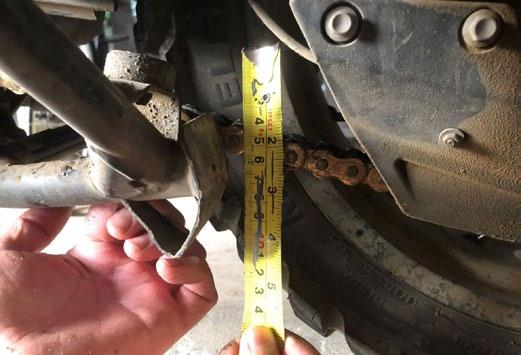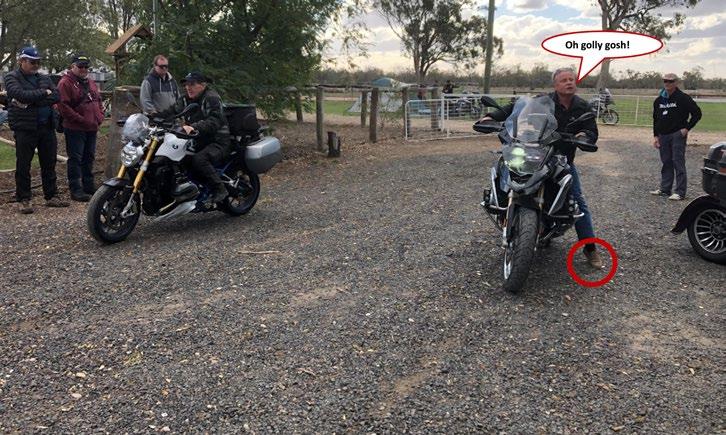
5 minute read
MAI NTENANCE CORNER
The Chain.....
By Duncan Bennett, Member #4171
What on earth is that? I hear all the >800 BMW crowd and most of the >=1200 of other marques (except KTM) asking. Well, back in your dim dark past when your parent or correctional centre warden decided you needed to become independent and get yourself off to a parole meeting, kindergarten or Sunday School, they taught you to ride a bike. Last time I watched the Tour de France, none of the competitors had a final drive hidden nicely inside some smooth looking swingarm, they had a chain. So if you ever had a bike, and it’s a rare kid that didn’t, you were exposed to a chain. A chain has many advantages; it is highly visible, able to shred the bottom of your school trousers, covered in a filthy mix of grease and what appears to be night soil, and will throw itself off at the most inconvenient moment such as when you are being chased by tough kids on dragsters. Same with motorcycle chains, although getting your school trousers stuck in one is a lot more difficult because you either threw them out or burned them 40 years ago. This article was inspired by a recent experience on the B2B16, see that in a few pages on from here, when my chain was discovered to be very loose and starting to rub on the centre stand guard - a big risk of a major drama. This was not a totally novel experience, so “chain awareness” is important especially if you like doing long trips. Firstly, how long do you get out of a chain and sprockets? Looking at the original chains on our new bikes - Cindy’s 2015 BMW 700GS, 35,000km. On my Triumph Tigers, about 48,000km and 36,000km. On Cindy’s current Tiger 46,500km and still going OK. Wildly different for chains doing similar duties on similar capacity bikes, but the range is usually somewhere between 30,000km and 48,000km. If you are over 30,000km, at least ask your service provider to give it a thorough check if you don’t like covering yourself in the grease/night soil mix. Don’t ask me how grease even gets on chains, we only use oil. All motorcycle manuals will describe how to tension the chain. The normal method is a bit motorcycle brand specific - some can be checked on the side stand, some on the centre stand, and some inconveniently have to be held upright off the stand while you try to check the tension and not drop the bike onto yourself or your partner’s Lamborghini. The usual allowed slack is between 25mm and about 40mm half way between the sprockets - make sure you measure in the same place. Too far forward and the chain will push up into the swing arm, too far back and the rear sprocket will limit movement.

25mm - this more than precise enough
Yes you can spend money on precise chain tension calipers but at risk of having the regular writer of this series or Mark Morrissey coming down hard on me, it is an allowable range so therefore not a thing requiring precision. If out in the scrub, a guesstimate is far better than not checking at all. Which brings me to the chain modes of failure and when to start worrying....

Chains are a sandwiched series of plates, seals, rollers, bushes, and rods. Each link is either an “outie” or an “innie”, just like belly buttons, and it seems just as prone to collecting lint and bits of pizza. The contact between the sprockets and chain is the roller which sits over the bush. The bush surrounds the pin, which fits into holes in the figure 8 plates and “fixes” the pitch or length between links. Fundamentally there is no real mechanical difference between the chain on a bulldozer and the chain on your motorcycle, it is just the size. Be careful using a “D” number if asking for a new chain though - a D9 chain needs a big sprocket set, but shouldn’t wear out at least as your pizzly 1000cc won’t even move it. The tensile strength of your average motorcycle chain is enormous. It can hold up to 5 tonnes when new. This allows you to do a full speed ABS rear braking without stretching, and an “I’m taking you Harley Davidson loser and Ferrari poser!!” drop-clutch burn-out and mono off the lights at the school pick up zone. And stringing up your world record Blue Marlin in Cairns. But, the large number of
19 contact surfaces between the pins, bushes, and rollers means that over time the whole shebang wears and next thing - stretch. Mostly a chain will stretch fairly evenly, for example Cindy’s chain in Africa where we’d nearly run out of swing-arm by the end but it was still ride-able. Same with mine - we had spares but should really have replaced them before we left Australia. Cindy’s current chain is starting the “I need a regular small adjustment thank you” phase. But my recent experience was that sometimes they don’t stretch evenly, and the chain tension will vary between “yellowing grandpa y-fronts waist” and “look at these guns, touch them if you want”. An unevenly stretched chain is frankly a nightmare - as the loose bits come around slack in the chain catches up to the drive sprocket and there is no power to the back wheel, then as it tightens again the power comes on. The variable tension on the front sprocket and seals is a probably a recipe for oil leaks at minimum - get a new chain. So onto some useful tips - use a lubricant spray every 300-500 km. Get a proper chain cleaner with bristles on three sides. If you haven’t got a centre stand it is frankly hard work, I had a technique with the older GS’ of pulling them over onto the side stand and lubing the chain, much harder now that they’ve moved the chain to the other side with the 750’s and 850’s. Another handy tip; mark where your axle is on the swingarm. If you ever have to take the back wheel off or adjust the chain tension, the thickness of the permanent marker is an easy way to either put the wheel back where it started or do easy adjustments. Happy chaining!















